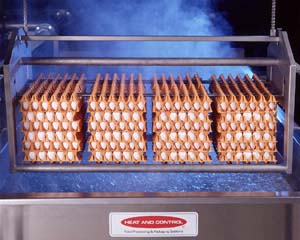Pasteurized Eggs L.P. Begins Marketing Bacteria-Free Egg

Table of Contents
The Promise of Pasteurization Over the Last Decade
Pasteurized Eggs L.P. Focuses Their Efforts on Creating Consistent Results
Pasteurized Eggs Signs First American Contract
In a December radio address on food safety President Clinton announced an initiative to reduce cases of food-borne illness. His plan takes direct aim at egg sources of Salmonella enteritidis, which cause about 300,000 cases of food poisoning in the United States each year. One of the tools the president mentioned is a relatively new technology called "in-shell egg pasteurization."
According to a 1998 USDA Salmonella Risk Assessment Report one out of every 20,000 eggs is contaminated. The egg industry implemented a self-monitoring program to reduce the number of bad eggs that make it to market. But some are hoping an in-shell pasteurization process developed by Pasteurized Eggs L.P., Laconia, N.H. will provide an additional safeguard. The process kills Salmonella bacteria present in the egg and prevents it from forming during storage.
"In-shell pasteurized eggs will appeal to people who have food safety concerns or who are using a recipe that calls for raw egg, like Caesar salad dressing," said Joanne Ivy, senior vice-president of The American Egg Board (Park Ridge, IL) in an interview.
Approximately 30% of the population are considered highly susceptible to the bacteria, including children, the elderly and those with compromised immune systems.
The Promise of Pasteurization Over the Last Decade
In-shell egg pasteurization technology emerged in the past decade—widespread Salmonella infection in chickens is a problem that only materialized in the early 1980s. Several research groups have studied the technology, including groups at Purdue University and North Carolina State University. In December a group of scientists at University of Missouri at Columbia was awarded a patent for their pasteurization technique. In 1997 the USDA approved an official identification of pasteurized shell eggs and, in the same year, the FDA began including pasteurized eggs in the Model Food Code. On the industry front, Minneapolis-based Michael Foods has sold a pasteurized egg in limited areas since 1996 under its Crystal Farms label, but hasn't yet launched a full-market effort.
The concept behind pasteurization is to heat something to a high enough temperature to kill dangerous bacteria. But eggs present a special challenge. Salmonella infects chickens' ovaries, entering the eggs before they're laid and settling mostly in the egg yolk. The heat must penetrate the egg yolk—without cooking the egg white. Researchers eventually discovered an effective combination of heat and time: Immersion in hot water around 140ºF for about a half-hour. But the difficulty of guaranteeing consistent results from egg to egg proved to be a deterrent to commercialization.
Pasteurized Eggs L.P. began their quest for an effective commercial pasteurization process about nine years ago. The company's president, L. John Davidson, was captivated by the challenge.
"The scope and almost impossibility of it really attracted me," Davidson said in an interview. "I got interested in the issue because eggs are a basic food that everybody eats, and yet there's a risk of illness. It's a worldwide problem."
Pasteurized Eggs L.P. Focuses Their Efforts on Creating Consistent Results
Today, the company holds three patents: A hot water pasteurization technique; a method of testing the egg once it's pasteurized; and a means for ensuring uniformity. In 1996 the company teamed with equipment manufacturer Food Processing Systems (Lancaster, PA), which built a machine to Davidson's specifications.
"We proved we could do it, but the mechanics weren't as good as we wanted," said Davidson.

Last summer, Davidson began working with Heat and Control, (Hayward, CA) to build another machine. He chose the company because of their know-how in controlling fluid bath temperature in high-volume food production. After eggs have been checked for cracks and rinsed, they are loaded into the system. After sanitizing the shells, the machine weighs the eggs and carries them to a series of sterilized, warm water baths. Next, the eggs are chilled to an internal temperature of 45ºF and rechecked for cracks. Finally, the machine applies an FDA-approved, wax-based sealant to protect the eggs from re-infection. The eggs are ready to be packaged and stamped with a special USDA seal.
Heat and Control has designed three versions of the system: The largest processes 1,000 eggs per minute, totaling 27 million dozen eggs per shift, per year. This machine costs $1.1 million. The smallest processes 8.5 million eggs per shift, per year, and costs $600,000.

Pasteurized Eggs signs first American contract
Pasteurized Eggs' first American client is a joint-venture between ISE America (Newberry, SC) and Kofkoff Egg Farm (Lebanon, CN). Production will begin soon in an ISE facility in South Carolina. Their agreement assigns Pasteurized Eggs a royalty per dozen sold. Davidson has also signed a marketing agreement with Daymon Associates, (Stamford, CN), to sell the eggs to supermarket chains. The eggs will be branded "Davidson's Pasteurized Eggs," and will cost consumers $0.36 more per dozen than standard eggs. Institutions will pay $0.24 more per dozen.
"We wanted the pricing to be very fair and the eggs to be available to the average person," said Davidson. "This is a singular opportunity for the egg industry to create a new image for eggs, reestablish market share and recreate profitability."
